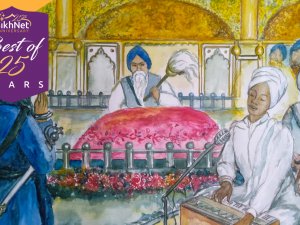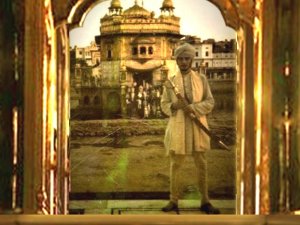Read Part I here
Read Part II here
Read Part III here
The passing of meditative awareness from Guru to disciple ensured spiritual continuity through the crucial centuries of the founding of Sikh dharma. Every Guru, from the first to the tenth, instructed his disciples in meditation. In their life, each of them also lived as an example of meditative awareness. At the end of every Guru’s life, he was then bound to choose the best among his disciples to take up his duties. The repeated and unfailing passing on of the discipline together with the virtues of guruship ensured the transmission of the living inspiration of Guru Nanak through succeeding generations.
The Mool Mantra was central to the passing on of the guruship. Indeed, it expressed the mool (root) of Guru Nanak’s teachings. According to historian Max Arthur MacAuliffe and his learned teachers, the first Guru communicated the Mool Mantra to Bhai Lehna, who would soon become his successor, only after he had passed Guru Nanak’s last test.
In Gurbani, the idea of paaras, the ‘philosopher's stone’ that converts ordinary stone into gold, is used to describe the personal changes exacted by the Guru. In the following verse known as a Vaar, Bhai Gurdas (1551-1636 CE), the writer of early Sikh history, describes the relationship of spiritual transformation uniting Guru and disciple.
In creating the philosopher's stone, lies the greatness of the philosopher's stone, the enlightened one. As a diamond is beautifully cut and shaped by another diamond, The Guru's illumined awareness brings out the light of consciousness in his disciple. At one with the Word, like a musician at one with their instrument, Guru and disciple, disciple and Guru, become one and the same. From one being, another came to be. It was ultimate being. (Vaar 9:9)
Elsewhere, Bhai Gurdas says:
From the Guru’s instruction, disciples are made,
but rarely does the Master make a second Master.
One who gives their mind to the meditative consciousness
of the Guru becomes like God. (Vaar 13:2)
As in Bhai Lehna’s case, the disciple’s consciousness was not only reshaped and transformed by the Guru’s grace, the disciple was also awarded the duties of guruship at the Guru’s passing. The following Gurbani, composed by Kal, a musician at the Guru’s court, describes the passage of the guruship, described here as the ‘throne of raj yoga,’ from Guru Nanak on to his successors, up to Guru Ram Das, the fourth Guru.
प्रथमे नानक चंदु जगत भयो आनंदु तारनि मनुख्य जन कीअउ प्रगास ॥
Parathme Nānak cẖanḏ jagaṯ bẖa▫yo ānanḏ ṯāran manukẖ▫y jan kī▫a▫o pargās.
ਗੁਰ ਅੰਗਦ ਦੀਅਉ ਨਿਧਾਨੁ ਅਕਥ ਕਥਾ ਗਿਆਨੁ ਪੰਚ ਭੂਤ ਬਸਿ ਕੀਨੇ ਜਮਤ ਨ ਤ੍ਰਾਸ ॥
गुर अंगद दीअउ निधानु अकथ कथा गिआनु पंच भूत बसि कीने जमत न त्रास ॥
Gur angaḏ ḏī▫a▫o niḏẖān akath kathā gi▫ān pancẖ bẖūṯ bas kīne jamaṯ na ṯarās.
With the treasure of the Divine discourse and gnosis of the Ineffable Lord,
ਗੁਰ ਅਮਰੁ ਗੁਰੂ ਸ੍ਰੀ ਸਤਿ ਕਲਿਜੁਗਿ ਰਾਖੀ ਪਤਿ ਅਘਨ ਦੇਖਤ ਗਤੁ ਚਰਨ ਕਵਲ ਜਾਸ ॥
गुर अमरु गुरू स्री सति कलिजुगि राखी पति अघन देखत गतु चरन कवल जास ॥
Gur amar gurū sarī saṯ kalijug rākẖī paṯ agẖan ḏekẖaṯ gaṯ cẖaran kaval jās.
ਸਭ ਬਿਧਿ ਮਾਨ੍ਯ੍ਯਿਉ ਮਨੁ ਤਬ ਹੀ ਭਯਉ ਪ੍ਰਸੰਨੁ ਰਾਜੁ ਜੋਗੁ ਤਖਤੁ ਦੀਅਨੁ ਗੁਰ ਰਾਮਦਾਸ ॥੪॥
सभ बिधि मान्यिउ मनु तब ही भयउ प्रसंनु राजु जोगु तखतु दीअनु गुर रामदास ॥४॥
Sabẖ biḏẖ māni▫ya▫o man ṯab hī bẖa▫ya▫o parsann rāj jog ṯakẖaṯ ḏī▫an gur Rāmḏās. ||4|| - Ang 1399
First Guru Nanak, like the moon, filled the world with bliss.
He liberated humanity with his illumination.
Guru Angad was blessed with the treasure of divine discourse and knowledge of God.
He overcame the five demons and so was freed from the fear of death.
Guru Amar Das, the great and true Guru, is the preserver of honour in this age of depravity.
Seeing his holy feet, one’s regrets and shortcomings are erased.
When his mind was in every way satisfied, he was pleased
And bestowed the throne of raj yoga on Guru Ram Das. (Siri Guru Granth Sahib, 1399)
This verse depicts the journey of self-purification and self-realization under the guidance of the Guru. It focuses first on the efforts of Guru Nanak’s most worthy disciple who eventually succeeded him as Guru Angad. Through meditation, he overcame his ‘five demons’ (also ‘five thieves’) of lust, anger, greed, pride and attachment. Before attaining the guruship, Guru Amar Das’s best disciple needed to satisfy his Master’s mind ‘in every way.’ Only then could he receive the throne of raj yoga and become Guru Ram Das.
Bhai Gurdas Singh wrote a similar Gurbani celebrating the relationship between Guru and disciple. It begins:
God created the throne of true being in the gathering of the true.
Nanak, the fearless and formless, plays among the fearsome yogis!
Later in the same Gurbani, Bhai Gurdas Singh describes the contemplative practice of Guru Har Rai, the seventh Guru:
The seventh Guru, the limitless Har Rai, who meditated with a neutral mind and realized oneness,
Raising the sky of his awareness, and finding unity in the cave of his mind, sat and felt unwavering samadhi.
The refrain of this well-known composition goes:
ਵਾਹ ਵਾਹ ਗੋਬਿੰਦ ਸਿੰਘ ਆਪੇ ਗਰ ਚੇਲਾ ॥੧॥
vaah vaah gobind singh aapay guru chaylaa ॥1॥
Great, great is Gobind Singh, himself the Guru and disciple!
Guru Gobind Singh composed Khalsa Mahima to celebrate the greatness of the Khalsa. In it, he repeatedly describes the Oneness between himself and his devoted disciples, using various images and relationships:
ਖ਼ਾਲਸਾ ਮੇਰੋ ਰੂਪ ਹੈ ਖ਼ਾਸ ॥ khalsa maero roop hai khhas
ਖ਼ਾਲਸੇ ਮਹਿ ਹੌ ਕਰੌ ਨਿਵਾਸ ॥ khalsa mehi ho karo nivas
ਖ਼ਾਲਸਾ ਮੇਰੋ ਮਖ ਹੈ ਅੰਗਾ ॥ khalsa maero mukh hai anga
ਖ਼ਾਲਸੇ ਕੇ ਹੌਂ ਸਦ ਸਦ ਸੰਗਾ॥ khalsae kae hon sadh sadh sanga
ਖ਼ਾਲਸਾ ਮੇਰੋ ਇਸ਼† ਸਹਿਰਦ ॥ khhalasa maero eisht suhiradh
ਖ਼ਾਲਸਾ ਮੇਰੋ ਕਹੀਅਤ ਬਿਰਦ ॥ khhalasa maero keheeath biradh
ਖ਼ਾਲਸਾ ਮੇਰੋ ਪਛ ਅਰ ਪਾਤਾ ॥ khhalasa maero pashh ar patha
ਖ਼ਾਲਸਾ ਮੇਰੋ ਸਖ ਅਹਿਲਾਦਾ ॥ khhalasa maero sukh ahiladha
ਖ਼ਾਲਸਾ ਮੇਰੋ ਸਤਿਗਰ ਪੂਰਾ ॥ khhalasa maero sathigur poora
ਖ਼ਾਲਸਾ ਮੇਰੋ ਸਤਿਗਰ ਪੂਰਾ ॥ khhalasa maero sathigur poora
ਖ਼ਾਲਸਾ ਮੇਰੋ ਸੱਜਨ ਸੂਰਾ ॥ khhalasa maero sajan soora
ਖ਼ਾਲਸਾ ਮੇਰੋ ਬਧ ਅਰ ਗਿਆਨ ॥ khhalasa maero budhh ar gian
ਖ਼ਾਲਸੇ ਕਾ ਹੋ ਧਰੋ ਧਿਆਨ ॥ khhalasae ka ho dhharo dhhian
Khalsa is my special form. I live in the Khalsa.
Khalsa is my face and limbs. I am ever, ever with the Khalsa.
Khalsa is my heart’s love. Khalsa is my fame and renown.
Khalsa is my past and future. Khalsa is my joy and happiness…
Khalsa is my complete true Guru. Khalsa is my fearless friend.
Khalsa is my wisdom and knowledge. Khalsa is always in my thoughts…
In the end, having gone on for many lines, the tenth Guru places but one condition on his relationship with the Khalsa:
Jab Lag Khalsa Rahe Niara, Tab Lag Tej Dioon Mein Sara
Jab Eh Gaye Bipran Ki Reet, Mein Na Karoon In Ki Parteet
So long as Khalsa remains distinctive, I will bestow on it all my glory.
But if they follow the way of the ritualists, I will not keep them in my faith.
The passing of the Guru Nanak’s meditative mind to Guru Angad, and continuing from Guru to most worthy disciple over several lifetimes, guaranteed the continuity and integrity of the Panth. Guru Gobind Singh expressed great pride and joy in his oneness with the Khalsa, the creation of two hundred years of growth and transformation. The Guru’s mind and heart lived on in the Khalsa. However, the tenth Guru also warned that if his Sikhs should ever leave his unique way of life and take up the path of Brahmanism, he would no longer support them in any way.






